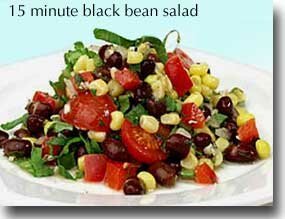If you don't know what to serve for dinner tonight ...
Try this salad recipe that only gets better with time. It is a great one to keep on hand in your refrigerator for a ready-made healthy meal or snack. Beans are great for adding dietary fiber to your Healthiest Way of Eating.

Ingredients:
- 1/2 cup minced onion
- 2 medium cloves garlic, pressed
- 2 cup black beans or 1 15 oz can (without BPA), drained and rinsed
- 1 cup frozen corn, thawed
- 8 cherry tomatoes, quartered
- 1/2 cup diced red bell pepper
- 2 TBS pumpkin seeds, coarsely chopped
- 1/4 cup chopped fresh cilantro
- 2 TBS extra virgin olive oil
- 3 TBS fresh lemon juice
- salt and black pepper to taste
- Mince onions and press garlic and let sit for at least 5 minutes to bring out their health-promoting benefits.
- Mix all ingredients together and serve. This salad will keep for a couple of days and gets more flavorful if you let it marinate in the refrigerator for awhile.
In-Depth Nutritional Profile for 15-Minute Black Bean Salad
Healthy Food Tip
The Latest News About Corn
What food is more synonymous with summer than freshly picked corn on the cob? Corn grows in "ears," each of which is covered in rows of kernels that are then protected by the silk-like threads called "corn silk" and encased in a husk. Corn is known scientifically as Zea mays. This moniker reflects its traditional name, maize, by which it was known to the Native Americans as well as many other cultures throughout the world. Although we often associate corn with the color yellow, it actually comes in host of different varieties featuring an array of different colors, including red, pink, black, purple, and blue. Although corn is now available in markets year-round, it is the locally grown varieties that you can purchase during the summer months that not only tastes the best but are usually the least expensive.
What's New and Beneficial About Corn
- You can get health-supportive antioxidant benefits from all varieties of corn, including white, yellow, blue, purple and red corn. But recent research has shown the antioxidant benefits from different varieties of corn actually come from different combinations of phytonutrients. In the case of yellow corn, it's the antioxidant carotenoids leading the way, with especially high concentrations of lutein and zeaxanthin. In the case of blue corn, it's the anthocyanins. There's one particular hydroxybenzoic acid in purple corn - protocatechuic acid - that's also been recently linked to the strong antioxidant activity in this corn variety.
- In research on carotenoid antioxidants in food, there has been ongoing debate over the availability of all carotenoids in any particular food if one or two specific carotenoids are present in unusually high amounts. Because yellow corn is a high-carotenoid food that contains highly differing amounts of individual carotenoids, researchers have long wondered whether it is possible to get health benefits from all of the carotenoids in yellow corn when their concentrations are sometimes so different. In yellow cornmeal, the carotenoids lutein and zeaxanthin fall into the high concentration category and reach a level of 1,355 micrograms per 100 grams. That level is nearly 14 times as high as the level of beta-carotene (97 micrograms per 100 grams). But thanks to recent research, we now know that absorption of beta-carotene from yellow cornmeal is only mildly compromised by the high levels of lutein and zeaxanthin in the cornmeal. In other words, in terms of carotenoid nourishm ent, we appear to get health benefits from all of corn's diverse carotenoids!
- We correctly think about corn as a good source of fiber. Corn is a food that gives us plenty of chewing satisfaction, and its high ratio of insoluble-to-soluble fiber is partly the reason. Past researchers have not been clear, however, about the ability of corn fiber to nourish our lower digestive tract. When you look at foods as a whole, they contain many different types of fiber, and when certain types of fiber reach the lower part of our large intestine (especially certain types of soluble fiber), they can be metabolized by intestinal bacteria into short chain fatty acids (SCFAs). This process not only helps support healthy populations of friendly bacteria in our large intestine, but also provides a direct supply of energy (in the form of SCFAs) to the cells that line our large intestine. With this benefit of this extra SCFA energy supply, our intestinal cells can stay healthier and func tion at a lower risk of becoming cancerous. Recent research has shown that corn can support the growth of friendly bacteria in our large intestine and can also be transformed by these bacteria into SCFAs. These SCFAs can supply energy to our intestinal cells and thereby help lower our risk of colon cancer. The amount of corn fiber analyzed in recent studies has been relatively high at 12 grams per day. That's the same amount provided by about 2.5 cups of fresh corn. While that amount might be more than you would consume at a single meal, it's an amount that you might easily consume over the course of several days. We suspect that future research will demonstrate the risk-reducing effects of smaller amounts of corn consumed over a longer period of time.

No comments:
Post a Comment